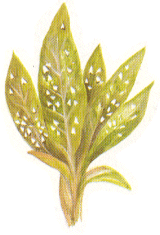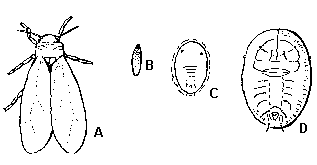|
|
Back to Pest Identification and Diagnosis
| Introduction to Whiteflies | Key to Whiteflies | Silverleaf Whitefly | Sweetpotato Whitefly | |||
| Greenhouse Whitefly | Citrus Whitefly |
AZALEA WHITEFLY
SCIENTIFIC NAME: Pealius azaleae
(Baker & Moles)
CLASS: Insecta
ORDER: Hemiptera
FAMILY: Aleyrodidae
 |
 A. Adult B. Egg C. Crawler D. Pupa |
|
|
Adult Azalea Whiteflies From: Mid Ulster Garden Centre |
Life Cycle From: NC Extension |
| DESCRIPTION | |
|
Adults: About 1.5 mm long, the adult is light yellow with the antennae and legs slightly lighter in color. Most of the body is covered with a white, waxy bloom. The eyes appear dark brown. As usual, the small moth-like adults fly about readily when infested plants are disturbed. Eggs: Azalea whitefly eggs are typical of other whiteflies in their irregular cylindrical shape that is somewhat pointed at one end and rounded at the other (base end). The base end has a tiny protuberance that is inserted into the leaf tissue. The eggs are 0.1 mm wide and 0.22 mm long. Color ranges from translucent creamy to dark gray tipped fading to paler gray at the base. Nymphs: The tiny nymphs, are oval and light in color without any form of wax secretions. Pupae: The pupal case is light yellow to an orange yellow in color, without any form of wax secretions and about 0.84 mm long. The marginal areas appear lighter in color than the mid-dorsal area. Some marginal indentations may be present when the pupal case has grown against the leaf hairs. |
|
| BIOLOGY | |
|
Distribution: This whitefly has been spread worldwide wherever azaleas grow. The first records in the United States were on plants received from Holland in 1910. Without a doubt azalea whiteflies occur in all southeastern states. Host Plants: Azalea whiteflies infest all species of azaleas. Damage: Infested plants become unthrifty, honeydew, and sooty mold detract from a healthy appearance. Unless controlled, large clouds of whiteflies take to the air when heavily infested plants are disturbed. Life Cycle: Little is known about this whitefly and its life cycle. Presumably it is very similar to other whitefly species. This whitefly overwinters as nymphs on azalea leaves. Adults emerge in early spring in North Carolina and lay eggs on the undersides of azalea leaves. The eggs are creamy and translucent, but turn gray as they age. |
| Introduction to Whiteflies | Key to Whiteflies | Silverleaf Whitefly | Sweetpotato Whitefly | |||
| Greenhouse Whitefly | Citrus Whitefly |
Back to Pest Identification and Diagnosis
 |
(C) Regents of the University of
Minnesota. All rights reserved. |
 |
 |